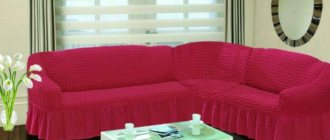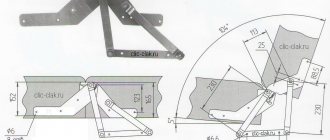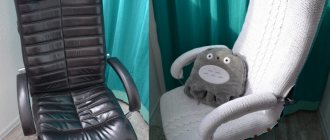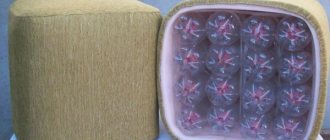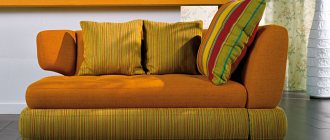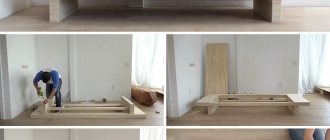Covers for upholstered furniture extend the life of its use or allow you to breathe new life into old furniture without resorting to rather complex and expensive restoration. Any housewife with a sewing machine can sew a decent sofa cover with her own hands. For example, how to sew a sofa cover in one evening, see video tutorial:
However, depending on the design of the sofa, its purpose and how it is used in the house, different types of covers may be best for a given sofa. Finally, the most in-depth lesson concerns one specific piece of furniture, and what to do if your sofa is just like that? Or do you want a completely different case for exactly the same thing? This article discusses how to design and sew a cover for a sofa of any type yourself, as long as you imagine how you want to see your favorite rookery.
Sofas with covers
Purpose
When discussing the purpose of covers for upholstered furniture, it is appropriate to recall the expression that a problem is easier to prevent than to solve. Sofas and armchairs are an important and expensive part of home comfort. Their main disadvantage is the rapid wear of upholstery fabric and vulnerability to persistent marks from food, drinks, animal hair and cat claws.
After a home renovation, expensive furniture may not fit into the new interior or may simply become boring. Do-it-yourself sofa covers can solve all the above problems. It is fair to say that such coatings:
- protect factory upholstery from dirt;
- are a decorative element;
- help to fit old upholstered furniture into a new interior;
- allow the owners of the sofa to change its appearance, for example, depending on the time of year.
There are a number of arguments in favor of making cases with your own hands:
- Saving money.
- Possibility of individual measurements and tailoring.
- Availability of a wide selection of fabrics, textures and decor.
- The ability to frequently update the upholstery to suit the new interior.
- No fear of damage to the factory cover by children and animals.
Despite the fact that modern upholstery fabrics have become more durable and varied, they still have a certain wear resistance limit.
Protection against stains and fur
Stylish decor
Choosing the right shape and design
Before you start sewing covers, you should take into account that furniture can have different shapes: rectangular, corner, shells. Sofa coverings must clearly correspond not only to the shape of the sofa, but also to its size.
All cases have their own functional varieties, depending on the purpose of their use. Let's look at the main options:
- Eurocase. It is sewn from a special textile material that can take any sofa shape. This fabric consists of special fibers with excellent elasticity. These capes are very practical. When sewing them, you do not need to take careful measurements of the sofa. They are perfect for corner models of any configuration.
- Covers with elastic are easily pulled onto the sofa and secured thanks to the sewn-in elastic. This covering is easy to make yourself, even without a pattern.
- Universal simple covers are made of elastic material. They are easy to make with your own hands. These sofa decks consist of two layers of special stretch textiles.
- Covers with a “skirt” at the bottom are frills located at the bottom of the product. When sewing, frills can also be made on the armrests. They are best suited for interior design in Provence and country style.
Eurocase
With a skirt
Universal
With elastic band
As for the design of the sofa deck, it should match the overall style of the room:
- Bedspreads of complex shapes are suitable for avant-garde interiors. They are made from material with rich decorative filling: drawings, prints, inscriptions, three-dimensional elements.
- Products in the English style are able to completely cover the furniture, accurately conveying all its contours. They require special sewing precision. Often used in a duet with various types of fastenings. They have a laconic appearance.
- For country style, simple covers made from natural fabrics in their natural colors are suitable.
- Sofa decks for loft interiors are made in an urban style. They are simple and have a minimum of details. These covers are easy to care for. Non-marking fabrics are used.
- Bedspreads for a high-tech style sofa have a laconic design. Usually these are plain blankets in neutral colors.
Vanguard
In English style
Country
Loft
High tech
Case latches made with your own hands come in different varieties. Buttons are especially suitable for rooms decorated with natural wood, when using floral ornaments. Velcro is suitable for covers in a nursery. The zipper is easy to use and is ideal for covering upholstered furniture in the office and living room. Ties look especially good in classic interiors.
Tools and materials
First of all, choose the right fabric. This can be any piece of durable fabric. The covers on the armrests get dirty very quickly and will have to be washed frequently, so the material must withstand numerous treatments.
Beginners in sewing should not immediately take on expensive fabrics. It is enough to take thick cotton fabric of a suitable color. It is convenient to sew from it, and finished products are easy to wash.
To work you will also need a standard seamstress kit:
- tape centimeter;
- threads;
- needles;
- tailor's pins;
- scissors;
- chalk or soap;
- sewing machine.
How to determine size
To sew a cover, you need to take proper measurements of the upholstered furniture in order to understand how many parts the pattern of the future sofa cover will include, and what shape of the cover should be sewn.
There is the easiest way to sew a sofa cover with your own hands - this is to use an old cape, if it has been preserved. It is ripped into its component elements, and then the resulting parts are transferred to the surface of the new fabric.
The volume of material needed to sew a cover can be easily calculated using the following scheme: you need to take two lengths and add two widths of the sofa to it.
Table of the main sofa parts that require measurements when making a cover:
| Options | Explanations |
| Length | The distance from the point where the rear wall of the sofa touches the floor to the point where the front of the seat touches the floor. In other words, this is the height of the back of the back + the height of the front of the back + the depth of the sofa + the height of the seat. |
| Width | Distance from one armrest to another. |
| Armrest width | Distance from the point where the armrest meets the seat to the point where the armrest meets the floor |
| Armrest length | Distance between the edge of the armrest and the point where the armrest meets the backrest |
Step-by-step sewing instructions
Let's look at how you can sew a sofa cover with your own hands in step-by-step instructions. There are three manufacturing options:
- No pattern.
- We will reveal it locally.
- According to the pattern.
| Preparation method | Model features |
| Without pattern | An elasticated cover for a sofa can be made without a pattern. This will require a large amount of fabric, based on the following: the width is equal to five widths of the seat, and the length of the fabric is 3 times the length of the sofa. |
| Cut according to location | Sewing such a cover is simple and very profitable. It does not require a lot of fabric consumption and leaves little waste after work (about 20%). Suitable for standard shaped furniture only. This cutting option is used to sew a cover for a sofa without armrests (non-folding or folding book with mechanisms, accordion). |
| According to the pattern | It has undeniable advantages. The fabric area is fully utilized, the cover fits perfectly on the sofa, and is not only original, but also a unique product. |
It is not recommended to start sewing a cover with furniture of a complex configuration, with a large number of rounded lines: it is much more reasonable to make a pattern for a straight sofa. Practice on the material that is available in abundance (for example, use old curtains).
Without pattern
Materials and tools
To sew a sofa deck, you need to prepare the following set of tools:
- Scissors. They must be sharp so that when cutting the fabric, creases do not form.
- Set of sewing needles. With their help, you can fix the details of a paper pattern on the fabric of the future cover. The more needles, the more comfortable the process of cutting out product elements.
- Sewing machine. In addition to the stationary one, it is also convenient to have a manual machine to work in weight.
- Yardstick. Needed to take measurements of the sofa.
- A simple pencil. Required for paper marking.
- Piece of chalk. Needed for marking the surface of the fabric.
All of the above tools, with the exception of a sewing machine, are usually available in any home.
Tools
Pattern of parts
To sew your own sofa covers, you need to make patterns. If the sofa has a simple rectangular shape or a corner model with a wall and back of a standard rectangular shape, then making it will not be difficult.
A pattern for sewing a sofa cover with your own hands requires accurate measurements of each detail. Measurements must be placed on graph paper, taking into account the direction of the split line. Then you should transfer the calculations performed to the material using chalk.
The markings must be applied to the wrong side of the fabric, taking into account seam allowances.
To make a pattern, you can use ordinary newspaper sheets. Carbon paper will also work. It is used to cover all the components of the sofa, outline their shape, and cut out the parts using scissors. They are all then assembled using tape. The resulting pattern is corrected right on the spot: the cuts are connected with tape, and the missing gaps are increased with new paper inserts.
After everything has been checked and joined, you should proceed to the stage of cutting on the material:
- The fabric must be ironed. Cotton and wool materials should be washed in warm water so that they shrink and the finished product does not decrease in size.
- Then the fabric should be folded with the right side inward. Pin the drawings using safety pins.
- Use chalk to outline the contours of the paper. Stepping back about 2 cm, draw a second line.
- Cut out the parts along the contour of the second line.
The result is cut parts, and the sewing phase can begin.
Pattern for a sofa cover
On a straight sofa
On the corner sofa
Sewing
The made pattern and step-by-step instructions for sewing a sofa cover require adherence to clear instructions. Sewing must begin with the basting stage. Sewing includes eight main steps:
- Sew the resulting parts using a running stitch.
- Try on furniture.
- Check that the parameters of the cover match the dimensions of the sofa.
- Sew the parts using a sewing machine.
- Finish the internal seams with an overlocker.
- Cut and sew the lining (if needed), and then sew it to the finished cover.
- Treat the fastener areas and edges of the product.
- If desired, decorate the case with decor.
The final stitching of all the parts of the cover will take about an hour. The main difficulty is that all the elements are massive and difficult to move under the needle.
Sewing a cover for a corner sofa with your own hands is not an easy task. There are two main manufacturing options:
- If a corner section is attached, then you need to sew 5 covers: for the main section, an extension, for the back and two armrests.
- If the corner section is insertable (or the sofa has a solid structure), then a simple pattern of a cover for a corner sofa is made separately for the “wings” and the corner of the furniture. Then all the parts are sewn together from the wrong side.
A cover for a corner sofa has a peculiarity: it always needs to be sewn in parts.
When stitching parts, it would be wise to use pleated fabric to disguise the joint (but only professionals can do this). It is much easier to choose the color of the material for the cover so that the seam is visually lost.
There is a little trick: you can make the seam between the parts much more hidden if you make it taking into account the fit of the fabric. And if the cape is made of coarse fabric (for example, canvas), then all seams can be made to fit.
Sew with running stitch
Trying it on furniture
Sew down the details
We process the seams
Sewing a sofa cover with your own hands
Once all the necessary tools have been prepared and the fabric has been purchased, you can begin taking measurements and sewing.
Note! It is recommended to pre-wash, dry and iron the material. Such actions will prevent possible shrinkage during operation.
Taking measurements from the sofa
You can sew a beautiful sofa cover only if you use a high-quality pattern. It is possible to cut a cover to fit the size of the sofa only if you take the measurements correctly.
Taking measurements from the sofa
To take measurements you will need a measuring tape. Use it to measure the sofa at its longest and widest point. This will be the length and width. You also need to take measurements of the armrests and headboard along the most protruding parts. To all measurements obtained, you must add 10 cm for hems and seam allowances. Add 20 cm to the edges that go inward. It is recommended to provide a fastener in the center of the product, so the cover can be easily removed.
Patterns of parts
Once all the measurements have been made, the results should be transferred to paper and the patterns drawn. Then cut out all the details on paper and attach them to the sofa. If everything fits, then you can start cutting on fabric. To do this, the fabric is ironed and folded with the right side inward. Then the parts are laid out on the material and pinned. After this, you need to outline the contours with chalk and, adding 2 cm, draw a second line along which the parts are cut out.
Jacquard covers for upholstered furniture
Calculation of material quantity
Before sewing a cover for a sofa in any room, you need to correctly calculate the amount of fabric. This stage is one of the first and most critical. First of all, you need to measure the length and width of the furniture, and then multiply the resulting result by two.
Microfiber sofa cover
For a more accurate calculation, after measurements it is necessary to draw the pattern details to scale, taking into account the width of the material, and also do not forget to leave seam allowances.
You might be interested in: Creating a pattern and sewing a beanbag chair with your own hands according to the instructions
Important! If the fabric for the cover has a pattern or geometric shapes, then the material consumption increases, since they need to be combined at the seams.
Secrets of quality tailoring
You can sew a beautiful and comfortable sofa cover with your own hands, even without certain skills. To do this, you just need to follow these recommendations:
- For a cape, you need to choose a fabric that is not very stiff, but it must be dense.
- It is best to make the pattern a little larger than the desired size. During the sewing process, it can be perfectly adjusted to the size of the sofa.
- If there are animals in the house, then the fabric should be additionally sealed with foam rubber.
- If minor mistakes were made during sewing, resulting in bad spots, you can hide them with the help of decoration.
- The pattern must be made extremely carefully, carefully planning the sewing and joining of parts.
- So that the cover does not experience stress when stretched, it must be made free. This product will last longer.
Do-it-yourself sofa cover for a children's room
Each time, sewing a cover will be easier, and the product will turn out more and more beautiful and better. Therefore, you can subsequently switch to more expensive textiles. Before sewing a Euro-cover for a sofa with your own hands, the step-by-step instructions should be carefully studied. If you are sewing a cape for the first time, it is recommended to use inexpensive material.
DIY sofa cover for the kitchen
Decoration options
To decorate a new sofa cover you can use:
- bows;
- ribbons;
- laces;
- decorative edging;
- patch;
- applique.
Such decorations give the stitched cover even more attractiveness and individuality. In addition to purely aesthetic problems, decor also solves camouflage problems, distracting from mistakes made when sewing a cover.
Despite the fact that today in specialized retail chains it is easy to purchase absolutely any decorative elements, from complex bows to gold monograms, when sewing a product yourself, it is reasonable to also make decorations for it yourself.
When decorating furniture, you need to take into account which room the sofa will be in and who will use it:
- If this is furniture for a children's room, then you should not decorate the covering with small and hard parts.
- If the sofa is for the dining room, then there may be no decor at all.
- If this is furniture for the living room, then there are no restrictions for decoration: everything depends only on desire and interior needs.
Decorative pillows are a wonderful and practical decoration for a sofa deck. If you sew covers on them from the same fabric, but in a different color, the result will be laconic and especially effective. A thematic trio made in the same style will look incredibly aesthetically pleasing: a sofa cover, decorative pillows and curtains.
Handmade covers for upholstered furniture come in different varieties. It is necessary to proceed from the target needs of users of furniture, interior design and taste preferences in color and decor. Before you begin the sewing process, you should choose a fabric and acquire all the necessary tools. A self-made sofa deck is unique and can rightfully be considered the pride of the owners.
With bows
With contrasting piping
With laces
Patchwork style applications
With ruffles and flounces
General recommendations for sewing
Despite the fact that a sofa cover is not a complex sewing item, the following recommendations should still be followed during its manufacture:
- When purchasing material, it is best to take fabric with a margin of about one and a half meters. In the future, the remaining textiles during operation will be useful for possible repairs.
- When cutting, you should not skimp. You can always cut off the excess, but you won’t be able to add material.
- It is not recommended to sew the parts together immediately, neglecting basting.
- Since the load on the seams during the operation of the cover is quite significant, it is recommended to stitch the parts twice.
- To make the seam stronger, the thread tension must be increased. It is best to use reinforced cotton or synthetic threads for sewing covers.
- Since too small stitches violate the structural integrity of the fabric fibers, optimal parameters should be selected. Recommended stitch length is 3 mm.
- If there are pillows on the sofa, then it is best to sew a cover for them with a zipper or Velcro fastener.
- To attach the cover to the sofa, you can sew piping or decorative cords to it. In this way the case can be securely fastened.
You might be interested in this. Examples of beautiful patterns for bodysuits and slips for newborn babies
If desired, you can decorate the sofa cover. In the form of decorations, you can use all kinds of frills, bows or embroidery. It should be borne in mind that accessories must be selected in the same style as the interior of the room.
European sofa cover with lace trim

